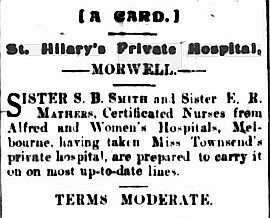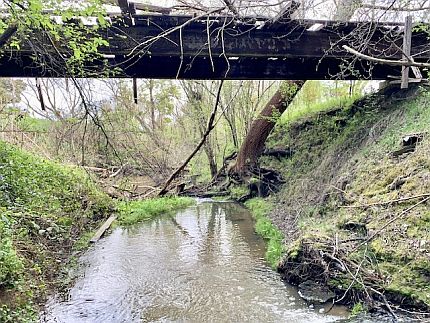Looking Back - December 2024 - Morwell History
By Leo Billington
Parts of Morwell’s history worth recalling
Years ago, the Morwell Advertiser, October 27, 1905, carried the following news:
The roads leading to Budgeree, Gunyah, and other centres are still in a deplorable condition, and the unfortunate settlers, who are obliged to travel them will be thankful when summer comes, and the mud and slush dispersed by old Sol (sunshine) who is the cheapest and best of road makers. Some of the trips to be frequently made by the settlers are really heart breaking to both man and beast. The unanimous opinion is that if the Government had given the money spent on the Boolarra-Foster road to shire council, the result would have been far more satisfactory. It is considered that twice the amount of work could have been carried out by the council in a satisfactory manner, for about half the money.
About two years earlier, the Morwell Advertiser, April 3, 1903 told its readers:
Mr Taverner, the new Minister for Lands has thrown open 9,000 acres in Gunyah Gunyah, and says he will bring in a bill for settlement, but Mr Livingstone does not like the idea of opening the country in scraps, and without provisions for a railway.
Mr Thomas Livingston was the parliamentary member for Gippsland from 1902. He was a dairy farmer in the Goulburn Valley before buying a dairy farm on the Agnes River in South Gippsland. Upon being elected to Parliament, he lived in Middle Park/Brighton until his death in 1922 , aged 71.
Based on his comment regarding a railway through Gunyah, Thomas Livingston was well out of touch with this part of Victoria.
There is a reason for these words about Gunyah (from your scribe who knew the area during one’s younger years), it has been mooted via Social Media that perhaps burials occurred at Gunyah.
It is well documented that there was not a gazetted cemetery in/at Gunyah. Perhaps the first officially recorded death was for 11 year old Gerald Quinn, who was accidently shot when with a friend, was out shooting parrots. Gerald was interred in the closest cemetery, at Boolarra on Tuesday, January 13, 1903.
Another former Gunyah resident, Mrs Ellen Perry, who died in March 1909, was interred in the Boolarra Cemetery. Miss Alice Bickerton of Gunyah died in 1911 from consumption, and was initially interred at Boolarra before being conveyed to the Woodend Cemetery. Another Gunyah resident, Mrs Emily Radburn was interred in the Hazelwood Cemetery on April 22, 1913.
Mrs Emily Radburn’s death was due to “an internal trouble.” Morwell Advertiser, Friday April 25, 1913. Emily was on this occasion, a patient at Mrs Townsend’s private hospital, which was located in a private residence at 258 Commercial Road, Morwell.
For anyone interested in reading detailed, accurate historical information about Morwell, find The Historical Society News, August 15, 1975. It is actually a repeat publication which first appeared in 1963. Compiled by the most authoritative local historian we have ever known, Mr I T Maddern - those who plug history stuff on Social Media should make his work mandatory reading.
Today, there is a carpark/office building at approximately 258 Commercial Road.
The next house was occupied by Dick Date, the blacksmith, and then came Mr Tatterson’s residence, the dentist. Finally there was Tim Kennedy's place, on the corner, originally built for Miss Nichol, one of the teachers at Commercial Road School. Dick Date was in business in Morwell for many years as a blacksmith and wheelwright, on the site once occupied by Stan Gude's garage in Station Street, approximately opposite today’s Morwell Railway Station.

Returning to Morwell’s first hospital. It was advertised in the Morwell Advertiser, March 12, 1915 that Sister S B. Smith and Sister E. R. Mathers, Certificated Nurses from the Alfred and Women's Hospitals, Melbourne, having taken Miss Townsend's private hospital, are prepared to carry it on; on most up-to-date lines. ‘Terms Moderate’. This was the start of St Hilary’s Private Hospital in Morwell.
An interesting conundrum: In 1910 the only hospital in Morwell was Miss Townsends Private Hospital, 24 Hazelwood Road. It was a private house with three bedrooms for patients. This hospital was purchased by nursing sisters Smith and Mathers in 1914 and they called it St Hilary’s. In 1922 a newly built 12 patient hospital at 16 Elgin Street was opened by Sister Mathers and it was called St Hilary’s. This hospital was sold to Sister Danaher who in 1941 decided to sell it. Morwell Historical Society - The Morwell Post; Vol. 37, No. 6; November 2018. A block of units now occupy approximately 24 Hazelwood Road.

Miss Townsend moved to Trafalgar and took over McDonald’s Private Hospital, located in Waterloo Road.
Debates about whether or not historical facts are accurate have raged on for decades, and will continue to do so.
Turning to another rather different and unique fact, there is a bridge perhaps euphemistically called the Hazelwood North bridge. It spans Waterhole Creek, which in a wet season, has a tendency to become rather fast flowing. This longstanding bridge is underpinned by solid two H-section steel structural beams. It is not clear when the bridge was built, but its presence allowed freedom of movement to and from farming land either side of the creek. It was wide enough for a tractor and even early model vehicles.
Hazelwood North is an historian’s oasis, if one digs deep enough.

On Saturday October 8, 1949, Hazel Jean Medew and Robert John Beasy were married in the Hazelwood North church. Hazel was the daughter of Mr and Mrs W Medew of “Devonlea”, Hazelwood North. Robert was from the Yarram district before living at Hazelwood North. Hazel and Robert are buried in the Cobden Cemetery.
Robert’s father, Charlie Caughey purchased about 100 acres for a dairy farm from Mr Thomas Fleming, who had formerly bought the farm from Mr Noble Tanner in May 1939. There is not much remaining of the Beasy farm buildings - although a dairy and hay shed stand stoically against Hazelwood North’s changing industrial landscape.


